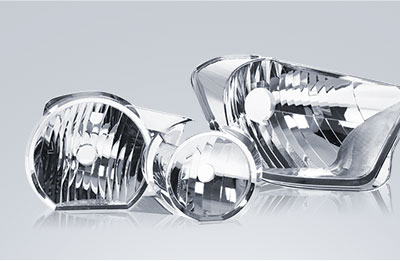BMC (Bulk Molding Compound)
Short for Bulk Molding Compound, BMC is a thermosetting composite molding material in bulk form with excellent formability. BMC is created by evenly dispersing and kneading glass chopped strands into a compound that is made by adding additives such as low profile agents, internal lubricants, and fillers to unsaturated polyester resin, which serves as a base.
-
The Characteristics
of BMC- 1) Since it has excellent fluidity, BMC makes it possible to mold large products as well as products with complex shapes.
- 2) BMC has excellent mechanical and electrical properties.
- 3) Due to its excellent dimensional stability, products molded using BMC have great levels of dimensional accuracy and have smooth surfaces (no sink marks).
- 4) BMC has excellent corrosion resistance and excellent weatherability.
- 5) BMC has high heat deflection temperatures and suffers little thermal aging.
- 6) BMC has an excellent self-extinguishing capability, and there are even high-grade types that have achieved a UL 94 V-0 rating.
- 7) BMC has excellent surface gloss and can be created in various colors.
- 8) BMC has an excellent vibration damping capability (motor encapsulation).
-
Handling Precautions
- 1) BMC contains a large amount of volatile styrene monomer. As a result, when volatilized, it becomes stiffened and can cause molding defects.
- 2) BMC comes wrapped in nylon film, and damaged packaging and remaining packing materials must be sealed with nylon film or al-laminated film.
- 3) As the pot life of BMC is less than one hour, it is recommended to use BMC immediately after opening its package.
- 4) It is recommended that BMC be stored in a cold dark place at a temperature of 20℃ or below. If BMC is stored in a place whose temperature is 10℃ or more above/below 20℃, the BMC’s pot life decreases by half. (Normally, BMC stored in a cold dark place at a temperature of 20℃ lasts for about two months.)
- 5) The packaging of BMC is often damaged during loading, so please be sure not to stack BMC in more than five layers.
-
Molding Methods
Compression molding, injection molding, or transfer molding is chosen depending on the shape, size, and quantity of the molded product.
| Method | Compression molding | Transfer molding | Injection molding |
|---|---|---|---|
| Use | Common products requiring strength | Products requiring insert-molding | Mass-produced products and areas requiring precision |
| Merits | Small quantity batch production Reduction of molding costs | Insert-molding/encapsulation The cavity can be widened. | Capable of mass production Excellent precision Excellent production processability |
| Molding conditions |
Forming temperatures: 150-170℃ Forming pressure: 100-200㎏/㎠ Clamping time Primary: 2-3 sec. Secondary: 2-3 sec. Tertiary: 5-10 sec. Molding time: 40-60 sec./mm |
Material preheating:40-70℃ Forming pressure: 130∼150℃ Forming pressure: 30-100㎏/㎠ Injection time: 5-15 sec. Molding time: 40-60 sec. |
Forming temperatures: 150-180℃ Forming pressure Primary: 500-1000㎏/㎠ Secondary: 300-500㎏/㎠ Molding time: 1-5 sec. Holding pressure time: 10-20 sec. Molding time: 20-30 sec. Screw RPM: 50-100 |
Introducing Our BMC Products

Our BMC products in this line are used for head lamps and fog lamp reflectors. Used specifically as materials for injection molding, they have excellent injection moldability and paintability (UV Base coating and aluminum vacuum metalizing).
Characteristics
- 1) They have excellent levels of heat resistance, which enable them to withstand the heat from halogen lamps (200℃).
- 1) They have excellent dimensional stability, which leads to a high level of the light distribution surface’s smoothness.
- 3) They have excellent vacuum metalizing capabilities.
- 4) They have good injection workability and mold very fast.
- 5) They do not produce fogging, which occurs when you leave a head lamp turned on for an extended period of time.
BMC Automotive Product Features Table
Grade
Characteristic
Application
Molding method
Data sheet
SN-425
Anti-Fogging
Head lamps and fog lamp reflectors
Injection molding
View technical sheets
Request MSDS’s
SN-425 (low specific gravity
Anti-Fogging
Specific gravity: 1.6
Head lamps and fog lamp reflectors
Injection molding
SN-203
Good injection workability
Head lamps and fog lamp reflectors
Injection molding
Major Customers
| Grade | Characteristic | Application | Molding method | Data sheet |
|---|---|---|---|---|
| SN-425 | Anti-Fogging | Head lamps and fog lamp reflectors | Injection molding |
View technical sheets Request MSDS’s |
| SN-425 (low specific gravity | Anti-Fogging Specific gravity: 1.6 |
Head lamps and fog lamp reflectors | Injection molding | |
| SN-203 | Good injection workability | Head lamps and fog lamp reflectors | Injection molding |
These products are used not only for head lamp assay and fog lamp assay products produced by Hyundai Mobis, SL Group Hyundai Motor, Kia Motors, Chevrolet, and Renault Samsung Motors, but also for those by Japanese and European automakers.





